How are we already halfway through the year? I feel like I’ve been out of town for most of this past spring, so this Joie Review will be heavy on travel recommendations (which I know you’ll enjoy).
Every January, I ask for the same thing from my family for my birthday: homemade cards and tear-along-the-dotted-line gift certificates that I can redeem for a yes day, a back massage, or a solo trip. I love cashing them in—especially when I need to escape humans and spend time writing, reading, or just resting.
This time, I was determined to make a dent in a book proposal I’ve been working on, and the only way I could do it was by removing myself from social temptations and parental obligations. Scroll down to the Travel Files to see where I took my computer to focus and dive deeper into my writing.
April also showered me with friendship and fellowship. One of my best friends was in town for her yearly visit to Paris, and I decided to revive a pre-COVID tradition: a salon I used to host called The Judys.
As always, I hope this review inspires you.
xx,
Ajiri
TROUVILLE
As I mentioned above, I cashed in my birthday coupon and headed to Trouville for a solo writing retreat. I truly love these solo trips—they give me a few days in a beautiful, inspiring location with minimal distractions to read, reflect, and make real progress on my writing projects. When I have no one to talk to or negotiate with, I can finally hear my own thoughts and dive deep into more complex ideas.
A friend recommended Hotel Flaubert, so I hopped on a train at Gare Saint-Lazare and arrived just two hours later at the Trouville-Deauville station.
This wasn’t a sightseeing trip—I was there to eat, sleep, and write—so I can’t offer a full guide to Trouville. However, I can share a few lovely restaurants I visited, some inspiring photos from around town, and, of course, a strong recommendation for the hotel, which was the absolute cutest spot and perfect for a solo stay.
Hotel Flaubert
📍Rue Gustave Flaubert, 14360 Trouville-sur-Mer | Instagram | Website
A charming 31-room hotel perched right on the beach, with that classic Normandy-meets-the-sea vibe. The rooms are simple, and I recommend booking one with a sea view, because that’s all the decoration you need. I wrote every morning and evening with the sound of the waves outside my window, and having the terrace to sit for tea was a dream.
Breakfast can be brought to your room or enjoyed downstairs. Although there is no on-site restaurant, the staff is happy to recommend local spots for lunch and dinner. I also spent time in the hotel’s cozy lounge bar, Le Bovary, reading and making notes when I needed a change of scenery from my room. It’s a beautifully layered space with ship-inspired antiques, toile fabric, chevron floors, and books tucked everywhere.

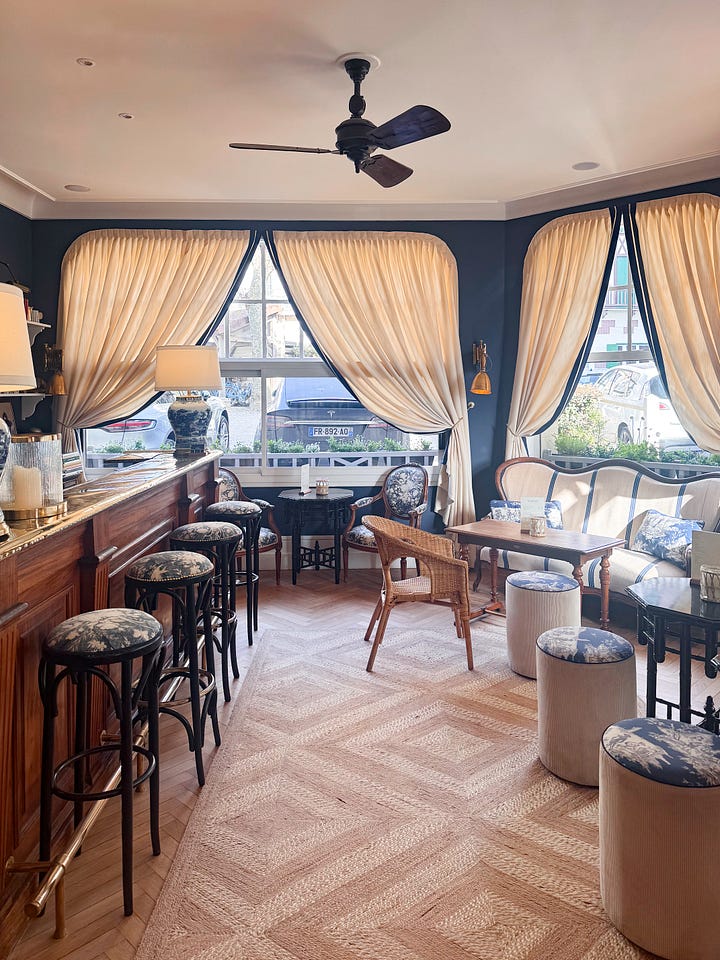
Bistrot Marcele
📍89 Rue des Bains, 14360 Trouville-sur-Mer | Instagram
You will find Bistro Marcele down a tiny street with a lot of outdoor seating and bistro classics like terrine de campagne, tartare, a house Burger, and oysters. It’s a bit of a meat lover’s menu. I ordered a glass of wine and the l’oeuf cocotte en cuisson spectacle au chorizo, which normally is a poached egg in a sauce. However, cuisson spectacle means cooking spectacle or show, and that’s exactly what it was. The egg cooks at the table in front of you in a glass jar heated from the bottom. It was a very fascinating show! I followed that with some lamb chops and a stroll through the cute little streets.


La Régence
📍132 Bd Fernand Moureaux, 14360 Trouville-sur-Mer | Website
This family-owned seafood restaurant sits right on the harbor in the center of town, with beautiful, ornate interiors dating back to the Regency era. I treated myself to a beautiful lobster for one, served with rice and sautéed vegetables. The mother took my order, the son brought out the plates, and the father was in the kitchen cooking—a true family affair.


Le Bar du Normandy
📍38 Rue Jean Mermoz, 14800 Deauville | Website
I couldn’t leave town without stopping into the famous Hôtel Barrière Le Normandy for lunch. The Belle Époque restaurant wasn’t open during the day, so I grabbed a table at Le Bar instead and ordered a Caesar salad. And honestly, sometimes all you need is a good Caesar, a quiet table, and a beautiful room to sit in for a little midday pause.


LA GRANDE MOTTE
When I told some French friends I was heading to La Grande Motte, their reactions were... mixed. One warned me not to post about it because it wasn’t “chic,” while another launched into a monologue about the town’s failed urban planning.
To be honest, it wasn’t my favorite stop on this trip, mostly because the weather didn’t cooperate. However, that worked out fine, as I was there to write and spent most of my time typing away on my computer.
What did intrigue me was the architecture—and more than that, the strong feelings it stirred. The French have a fascinating relationship with modernity. Do they dislike these buildings because they’re too new? Too sculptural? Too ambitious? Too big? For me, I felt a sense of something missing. Charm perhaps. There was no visible town center where old men were playing pétanque, teenagers were flirting, and couples were debating life over glasses of rosé.
Still, the story of the place is utterly fascinating. Designed in 1965 by Turkish-born French architect Jean Balladur, La Grande Motte was part of a post-war government initiative to create working-class resort towns along the Mediterranean. It was envisioned as an affordable alternative to the pricey French Riviera or the Spanish Costa Brava—offering modernist leisure for the masses, surrounded by beaches and nature.
I recommend reading Alice Cavanagh’s New York Times article about it here. Though she leaves out one interesting detail someone shared with me: apparently, there’s a masculine and feminine side to the town based on the architecture. I couldn’t verify that information anywhere, though.
If you're an urban planning enthusiast or want to take some delightfully eerie photos, it’s worth a drive-through. That’s the only recommendation I can offer for now.




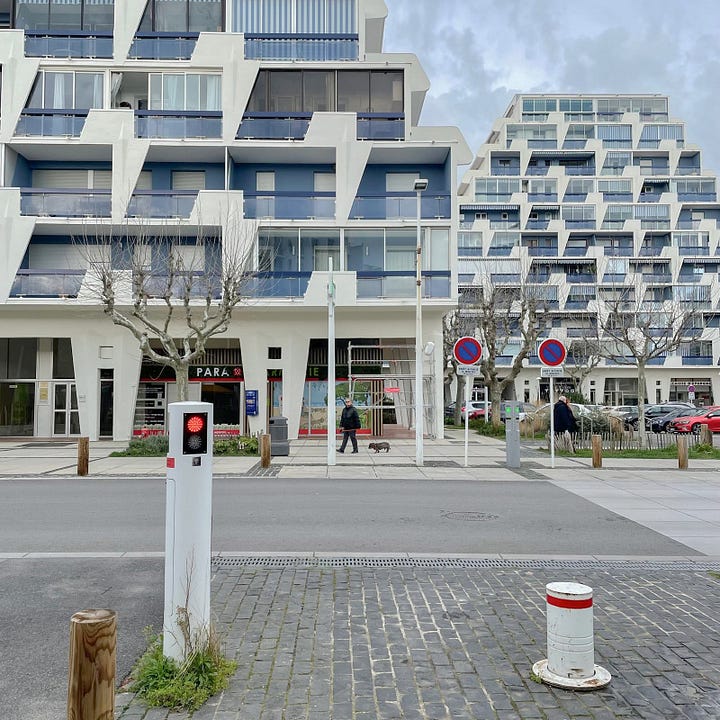
THE VAR
You all know how much I adore the Luberon... but lately, the Var region of Provence has been quietly stealing my heart. Over the past few years, I’ve found myself drawn more and more to this stretch of the South, especially to places where I can glimpse the Mediterranean shimmering in the distance right from my window.
We’ve slowly made our way through many of the charming towns: Ramatuelle, Gigaro, Rayol Canadel-sur-Mer, Grimaud… and this time, we settled into Cavalaire-sur-Mer. We also once did a family sabbatical for a few months in Montfort-sur-Argens, next to Miraval, which is all further north in the Var. And no we never saw Brad and Angelina.
People often assume the Var’s coastline belongs to the Côte d’Azur—mostly because Saint-Tropez gets lumped in with all the Riviera bling. But technically, they’re not the same. While the Côte d’Azur leans into glam and glitz—think Nice, Cannes, Monaco—the Var is a touch wilder, a bit more low-key, and far less polished. There’s a slower rhythm here, and fewer mega-yachts (unless, of course, you’re in Saint-Tropez). You still get the turquoise waters and golden light, but it feels less touristy and more discoverable. There are so many charming towns and villages that feel delightfully untouched.
Now, let’s get to the good stuff—where to eat. We cooked at home quite a bit, but we also ventured out for a few memorable meals, revisiting our favorite spots and trying a couple of new ones. The coast is dotted with endless delicious restaurants, but here are just a few standouts from this trip to add to your Travel Files.
Restaurant La Plage
📍Plage de Pardigon, 83240 Cavalaire-sur-Mer | Website
Not the most original name for a restaurant, but we arrived and got a perfect table right next to the sand, where the kids could run around while we enjoyed lunch. I don’t remember anything about the food, if I’m being honest—but I’d still go back for the toes-in-the-sand setup and the easy rosé vibes.
Restaurant La Pesquière et Le Mazagran
📍1 rue des Remparts, 83990 Saint-Tropez | Website
We were trying to avoid the overcrowded Sénéquier, so we meandered through the back streets and stumbled upon two sister restaurants tucked into a quiet corner of town near the water. Since they’re off the main strip, they felt like local secrets—though clearly not too secret, because we still waited a good 20 minutes for a table. Next time, we’ll try to book ahead.
It’s a family-run spot, and we ended up on the Le Mazagran side. If you like mussels, I can’t recommend the moules Pesquière enough. What a pleasant surprise. The mussels were cooked, then served cold with a tomato, garlic, and herb relish spooned over the top. I loved it so much, I’m planning to try and recreate it at home.
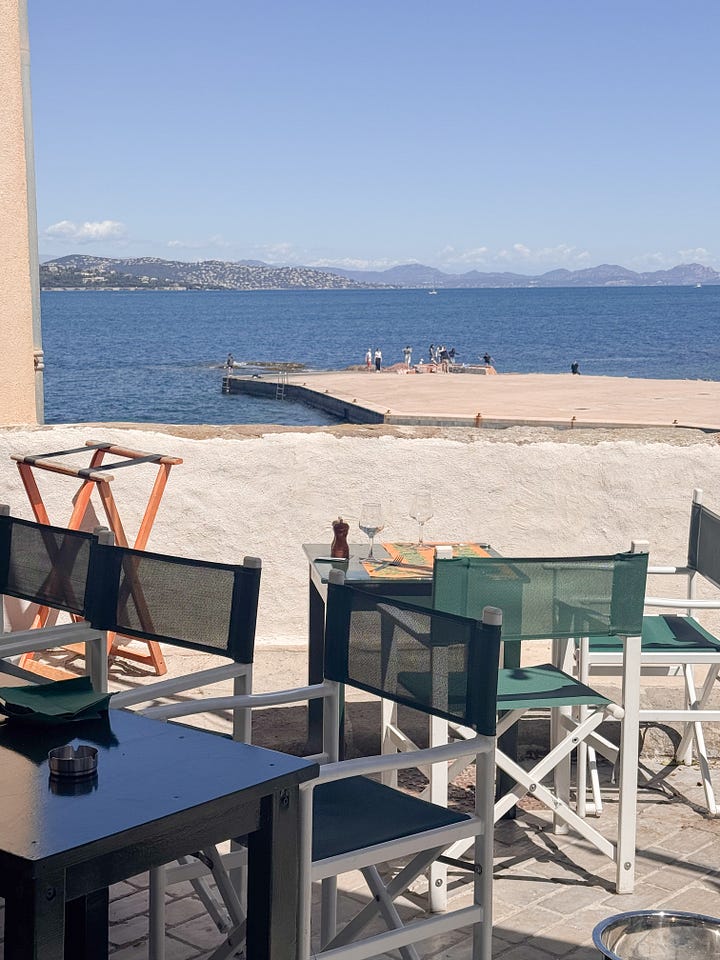

Sénéquier
📍29 Quai Jean Jaurès, 83990 Saint-Tropez | Instagram
Yes, it’s iconic, and yes, it’s a bit of a scene—but grabbing a table at Sénéquier for people-watching with a glass of rosé still feels like a Saint-Tropez rite of passage. We’re also completely obsessed with their pavlova, mostly because of the surprise tucked inside: a scoop of vanilla bean ice cream hidden in the center. Of course, you can go classic with a tarte Tropézienne, but after tasting that pavlova, I can’t go back. That said, we usually pick up a Tropézienne from their patisserie to take home for more dessert later.


Pépé
at Hotel Lily of the Valley
📍Gigaro Beach, 83420 La Croix-Valmer | Instagram
Maybe one day I’ll get to stay at the fancy five-star hotel Lily of the Valley, but for now, we return each year to their more relaxed beachside restaurant, Pépé. They don’t take reservations, so we usually arrive right at noon, enjoy a big, beautiful lunch, and then rent chairs to nap it all off on the beach.
Lily of the Valley also has two elegant restaurants—Brigantine and Vista—but we always choose Pépé so the kids can play in the sand and run back to the table when they feel like it. It’s casual, easy, and exactly the kind of lunch that feels like vacation.
In my twenties, I used to meet with a group of Mexican girlfriends every Thursday. We called it Juevesitos—“the little Thursdays”—and every single week, there was always someone’s house to go hang out at. The host provided the food, and everyone else brought the wine. Sometimes we’d go all out and chip in to have tamales catered. It remains one of my favorite memories from my decade in New York City.
Now, we’re all older and everyone’s schedules are a bit more chaotic, but I’ve decided to bring the spirit of Juevesitos back—on a monthly basis. In April, I revived a pre-COVID salon I used to host called The Judys. It’s inspired by the wild and loud magic of Judy Garland and the joy of gathering on a Thursday.
As a little nod to Priya Parker’s book The Art of Gathering: How We Meet and Why It Matters, I invited guests to wear red or sparkles and, upon arrival, to write down their celebrity alter ego. This simple prompt led to so many laughs as everyone went around trying to guess who was who.
For the décor and food, I kept things simple and manageable, since I only planned it two days in advance. I picked up red and pink flowers and tucked them into antique bud vases down the center of the table. (They’re actually oil and apothecary jars I collect from flea markets.)
I asked each guest to bring a dip, and I pre-set a grazing table with breads, crackers, crudités, and plenty of room to showcase everyone’s creations. I also added madeleines from the Ritz Comptoir and a few sweets to round things out.
The vibe felt very Judy G: bold, fun, a little crazy, and full of joy. Everyone was so happy to gather, and we lingered in conversation on a perfect Spring day.
If you're feeling inspired to host something yourself—but maybe a little intimidated or short on time—I highly recommend choosing a fun theme, and don’t be afraid to ask each guest to bring something. It makes the gathering feel shared and easy. Add a little game or prompt that gets people giggling or sharing something meaningful. Sometimes, all it takes is a sparkle dress code and a secret alter ego to make a Thursday night memorable.
Maison Victor Hugo
📍6 Places des Vosges, 75004 Paris | Website
All the time I have spent picnicking in the Place des Vosges, I never realized the Maison Victor Hugo museum is tucked away in a corner overlooking the park. The museum is free and a great hour spent learning about his life as a prolific writer and involvement in French politics in the home he lived in before his temporary exile from France. There is also a cute garden cafe-restaurant for lunch or a cafe after your visit.
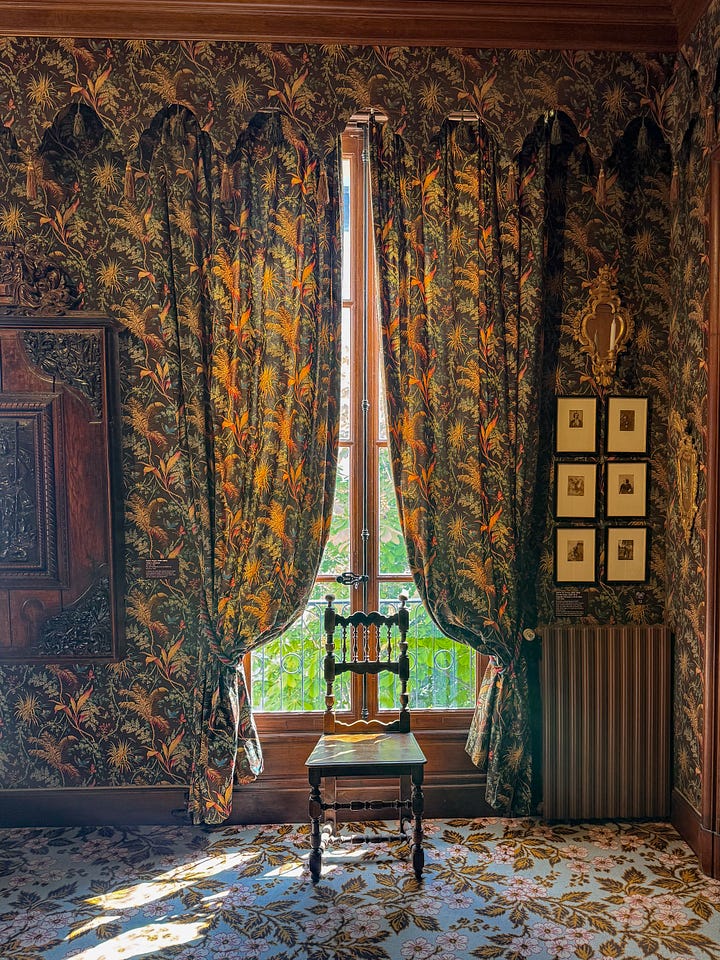

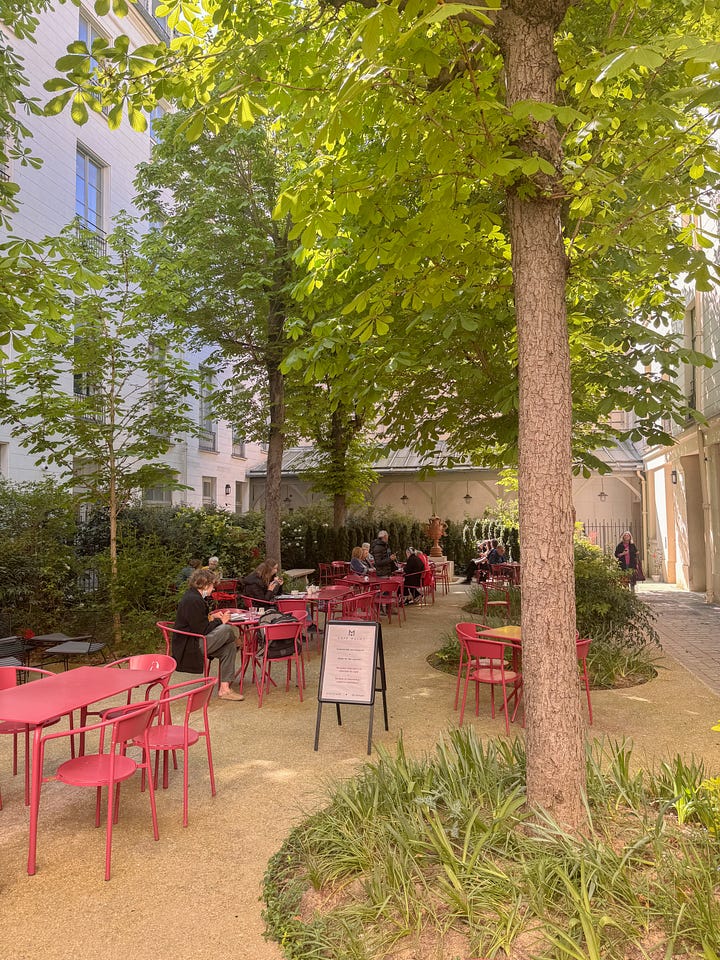

Le Ritz Comptoir
📍38 rue Cambon, 75001 Paris | Website
📍45 rue de Sèvres, 76006 Paris
The Ritz has stepped out of Place Vendôme with two pastry shops—one on rue Cambon and a newer one on the Left Bank across from Le Bon Marché. Pastry chef François Perret’s creations are beautiful reimaginings of the classics: croissants and pains au chocolat in flaky, tubular form, and glazed madeleines with delicate fillings that are light on sugar and perfectly balanced.
The éclairs are exclusive to the rue de Sèvres location, and the vanilla one is especially worth the detour—light, fluffy, and unforgettable.
Seating is limited at both locations, so grab a sandwich and a few sweets to go, then head to the Tuileries or Square Boucicaut for a chic Parisian picnic.

Imaginary Country
Perrotin Gallery New York, 130 Orchard Street
June 12, 2025 - August 1, 2025
More info here
It’s always a good idea to get to know your neighbors—you never know when they’ll become allies or future dear friends. At a fête des voisins (neighbor party) many years ago, I met Christiane Pooley, a tall, soft-spoken Chilean painter with easy grace, quiet curiosity, and a warm, contagious laugh that makes her immediately likable. I had no idea then just how deeply smart and talented she was—not until I saw her work.
Her paintings stunned me. They appeared simple at first glance, but beneath the surface lay extraordinary complexity.
This summer, Christiane will present her first solo exhibition in New York City with the renowned Perrotin Gallery. Titled The Landscape Is Not the Territory, the show explores memory, history, and displacement through imagined and real terrains. Her dreamlike compositions—lakes, floating homes, trembling earth—carry echoes of southern Chile, but just as often slip into abstraction, becoming places of metaphor and inquiry. She invites us to consider not just what we see, but the layered stories a landscape holds: cultural shifts, buried memories, seismic change.
One painting shows homes sliding into the sea, a haunting reference to the devastating 1960 earthquake in Valdivia. Others channel the romanticism of old-world panoramas, fractured quietly by the uncertainties of modern life. There are brushstrokes and stains, soft fades and sharp seams—like the earth itself cracking open to reveal its past.
Whether viewed up close or from across the room, Christiane’s grand canvases mesmerize. They are beautiful in that layered, thoughtful way I’m always drawn to—where beauty draws you in, but meaning keeps you there.
While clearing my inbox (instead of writing), I stumbled on a Gardenista email filled with beautiful images—perfect fuel for procrastination. One led me to an old article about Mary Jo Hoffman and her book Still: The Art of Noticing.
A former aeronautical space engineer, Mary Jo began photographing objects from nature in her mid-forties. With two young kids and a desire for a creative outlet, she committed to a daily practice: arranging what she found—leaves, branches, feathers—on a white background. It became a way to make art, stay disciplined, and, most importantly, notice.
Her book is filled with these quiet, patterned compositions, and her reflections. One line especially stayed with me:
“Finding each day’s subject required me to live more often than not in a heightened state of awareness that I found made me extraordinarily happy, because I was not just sleepwalking through the obligations of a busy life but seeing and noticing, all the time.”
She references Jenny Odell’s How to Do Nothing, another favorite of mine, which encourages stepping away from the attention economy and reconnecting with the world around us—a concept known as bioregionalism.
Inspired by both, I started my own May ritual: finding and sharing one beautiful thing each day on Instagram.
If you love nature, color, pattern, or simply a thoughtful book about art and paying attention, Still is worth lingering over.
Notice one beautiful thing each day—something from your environment, not someone else’s highlight reel. It could be a small architectural detail, a wildflower pushing through the sidewalk, or a forgotten local story waiting to be uncovered. Let this be a daily ritual of attention, inviting you to find joie, awe, wonder, or simply beauty all around.
I devoured the book Crush by Ada Calhoun. The characters frustrated me, but I wanted to know what final decision she would make with her life.
Midlife seems to be trending lately, which works for me. I recently came across a Rich Roll episode featuring Chip Conley and found a lot of thought-provoking insights. The episode is long, so I had to break it up into a few sessions, but it’s worth the time. It’s called The Modern Elder: Reframing Midlife, Cultivating True Wisdom & Finding Purpose in Life’s Second Half.
We all need to learn to say “no” and then be reminded constantly. Michelle and Taraji are here for backup in this podcast that everyone needs to listen to:
Did you catch my latest Table Topics with Lindsey Tramuta, who also recently released a new book for Eater? (Full disclosure: I shared a weekend itinerary for your travels to Provence in the book.)
There are a few spots left in the Marrakech retreat this November! Want to join me as we get inspiration from all the beautiful design and lively conversations around tables clinking glasses and eating great food? Sign up here.






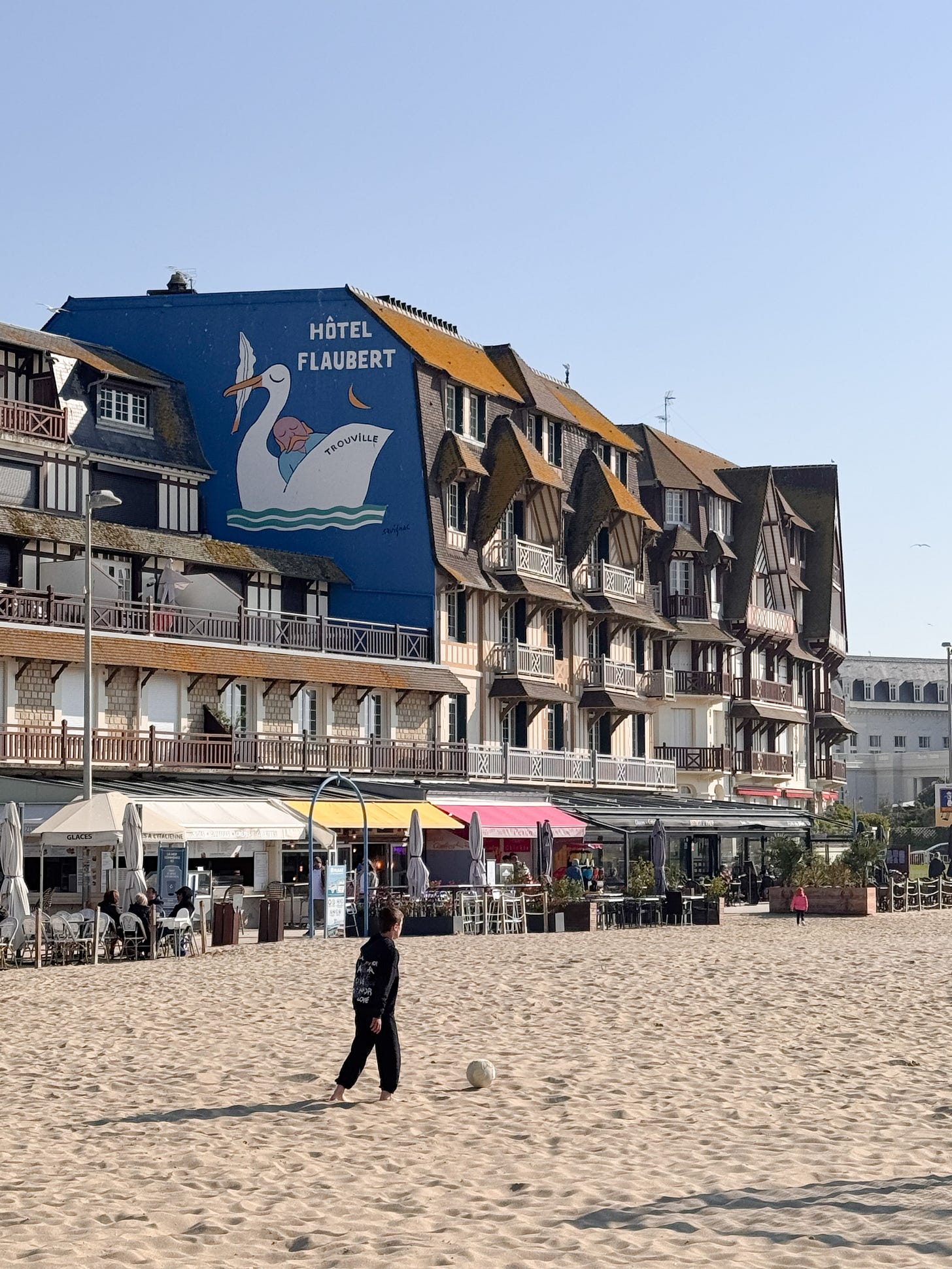



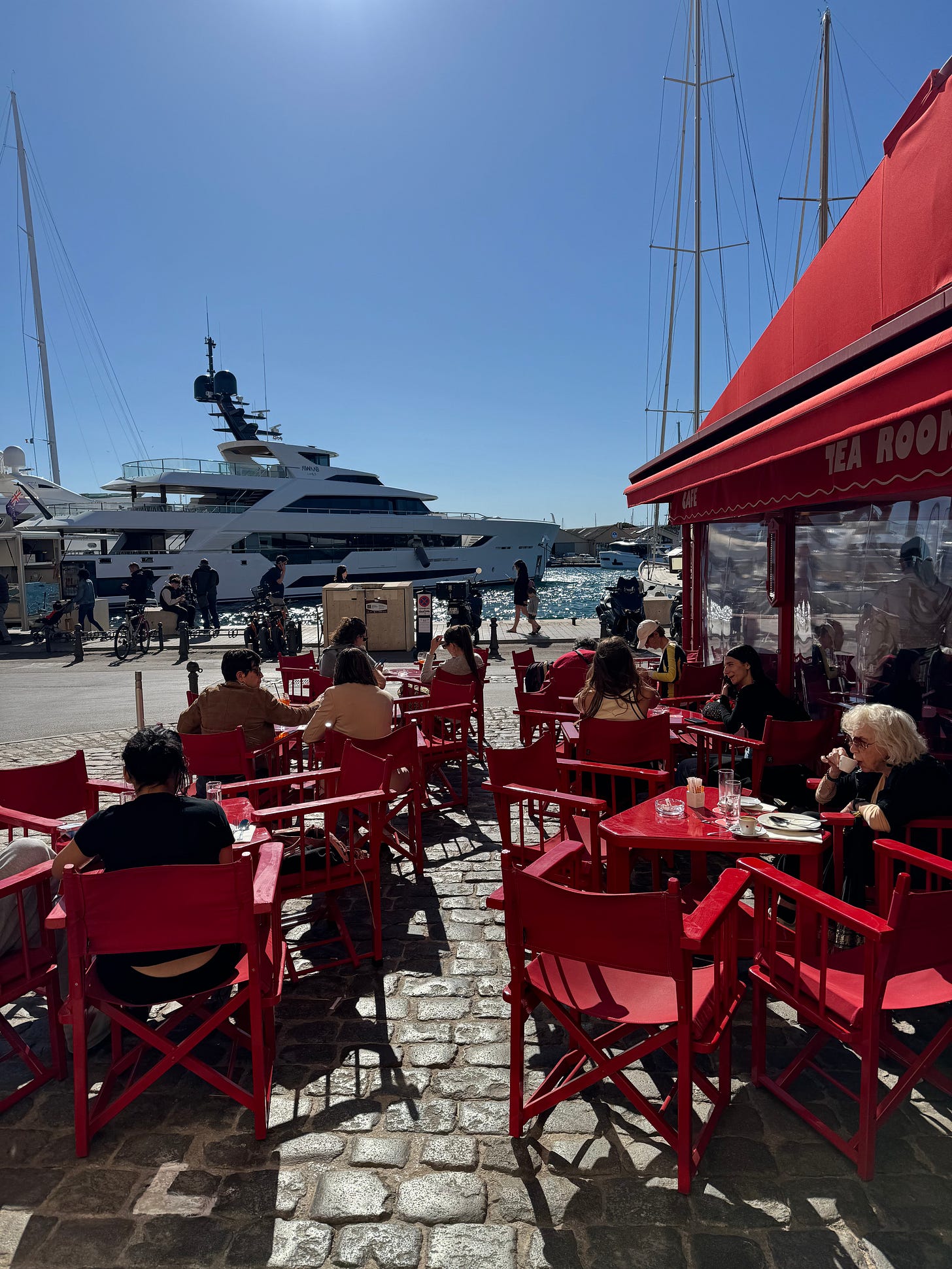











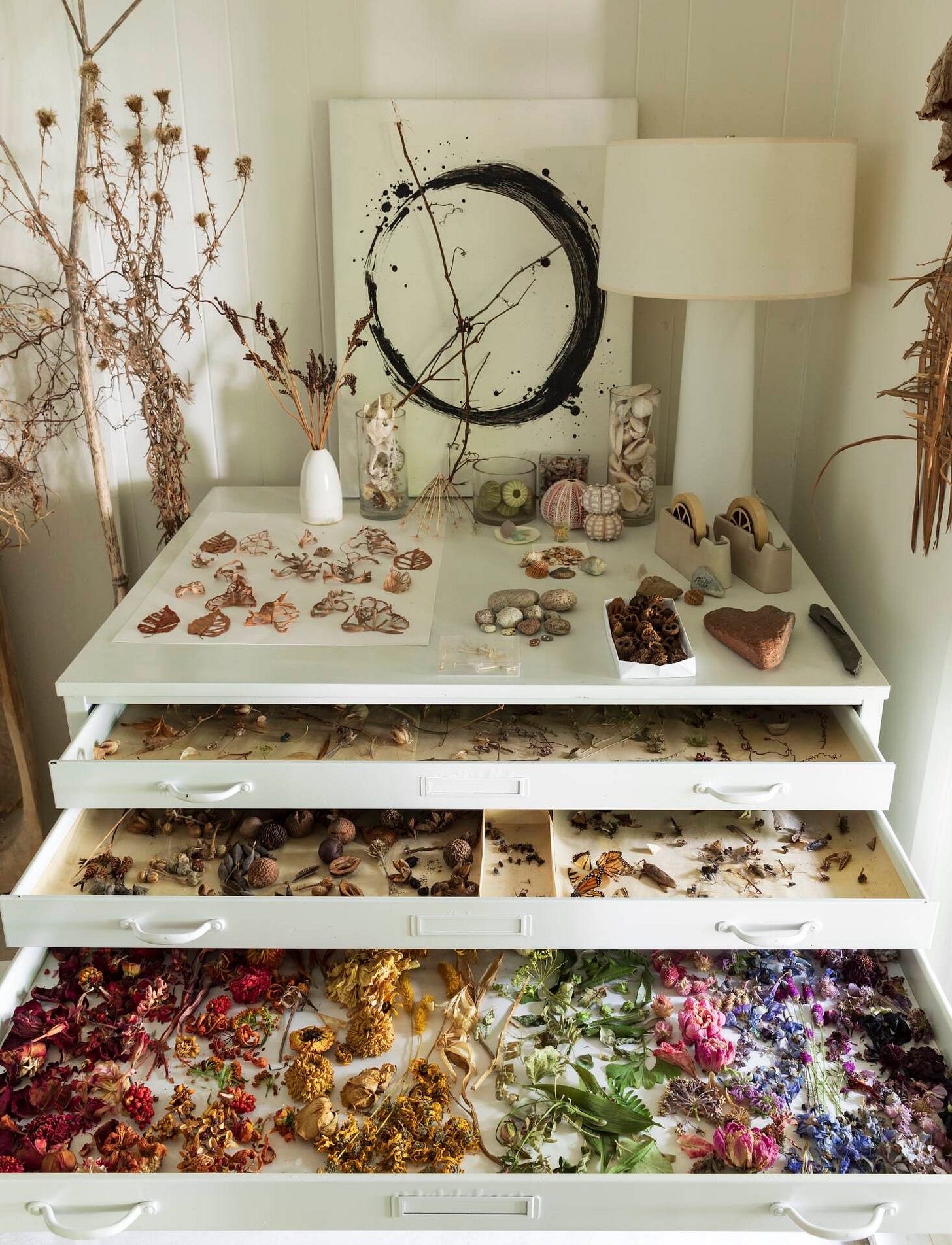






Ajiri, where in Texas are you from? I’m from Houston and live here in France in La Rochelle. Love your Substack and plan to come take a tour with you in Paris. Best always.
So much to savor!